Move your mouse over the pictures to see the names of the various features.
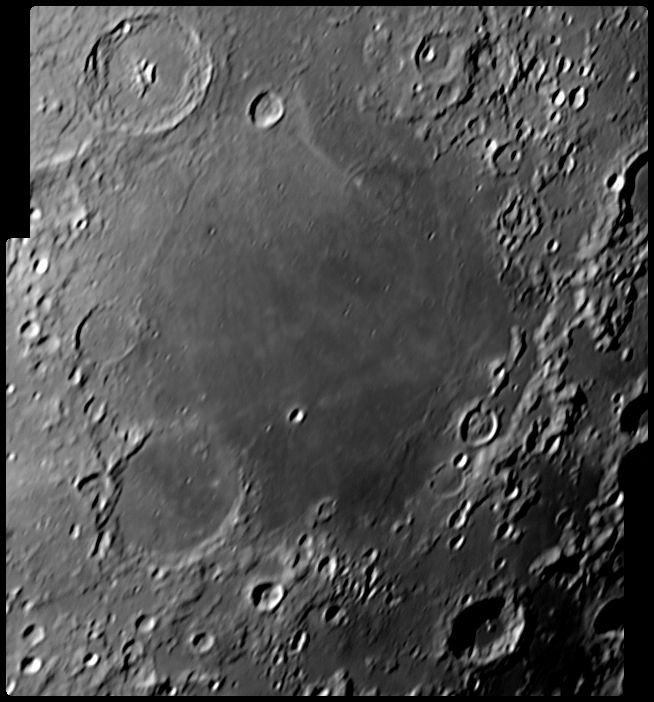
|
This is a mosaic of two pictures covering the whole of Mare Nectartis but not the whole of the basin. The Sun is in the west at an altitude of about 16° at the centre of Mare Nectaris (higher to the west, lower to the east), so it is late-afternoon there on the Moon. The shadows are quite short and will only be produced by slopes steeper than the height of the Sun. So the western ramparts of most of the craters in this picture are either not very high (Fracastorius and Beaumont) or not very steep (Theophilus).
The scale markers are approximately 100 Km north and west.
The pictures were taken with a ToUcam attached to my LX200 on 10th September 2006, when the Moon was 18.4 days old.
Lunar Phase: 315.9°
Colongitude: 128.9°
Date and Time: 10th September 2006 22:13 UT
Camera: ToUcam 740K in B/W mode
Telescope: LX200 at prime focus
Capture: K3CCDTools. High gamma, 1/250", 11% gain
Processing: Registax. Wavelet 1-2 = 10, contrast 130, gamma 0.9
|
|
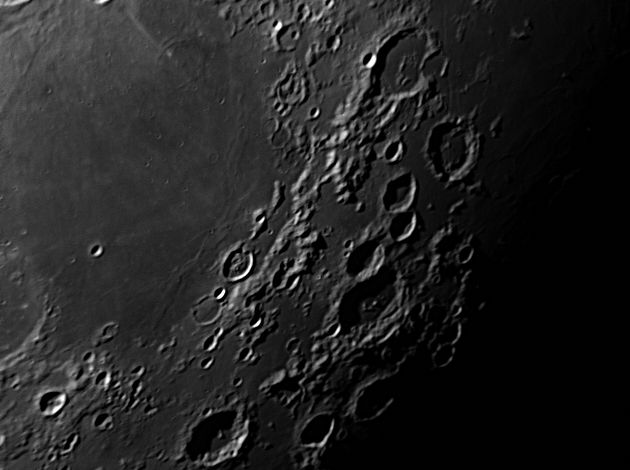
|
Here is the area to the east of the picture above taken at what was early evening on this part of the Moon. The lighting is almost identical to that in the picture above.
The scale markers are approximately 100 Km north and west.
The picture was taken with a DMK camera attached to my LX200 on 28th August 2010 at 0140 UT, when the Moon was 17.8 days old.
Lunar Phase: 323.2°
Colongitude: 130.6°
Date and Time: 28th August 2010 01:40 UT
Camera: DMK 21AF04
Telescope: LX200 at prime focus
Capture: ICcapture. 1/120", gain 668, 2843 frames
Processing: Registax. 100 frames stacked, wavelet 1-2 = 10
|
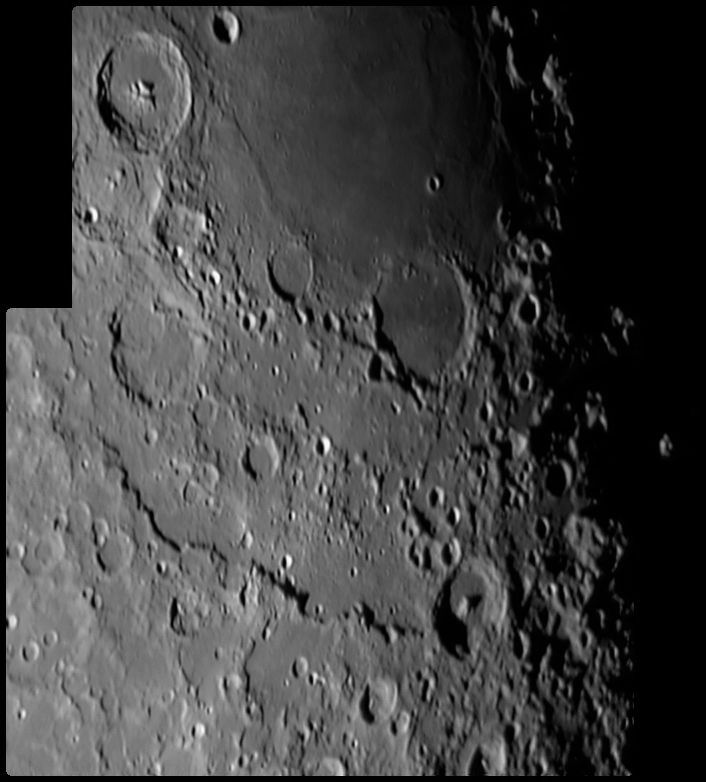
|
This is a mosaic of two pictures of an area to the south of Mare Nectaris. Fracastorius is an ancient crater, about 3,900 million years old and 130 km in diameter,
whose northern walls are broken down and lava appears to have flooded in from Mare Nectaris. Its other walls, however, are steep and high. The most dramatic feature in this picture is the Rupes Altai, an escarpment 500 Km long and up to 1000 metres high. At its southern end is Piccolomini, 90 Km in diameter, 4500 metres deep, and with an imposing central mountain with four peaks.
The scale markers are approximately 100 Km north and east.
The picture was taken with a ToUcam attached to my LX200 on 28th February 2005 at 0200 UT, when the Moon was 18.4 days old.
Lunar Phase: 315.3°
Colongitude: 140.6°
Date and Time: 28th February 2005 02:00 UT
Camera: ToUcam 740K in colour mode
Telescope: LX200 at prime focus
Capture: K3CCDTools. High gamma, 1/100", 0% gain
Processing: Registax. Wavelet 1-2 = 10
Image converted to monochrome.
|
|
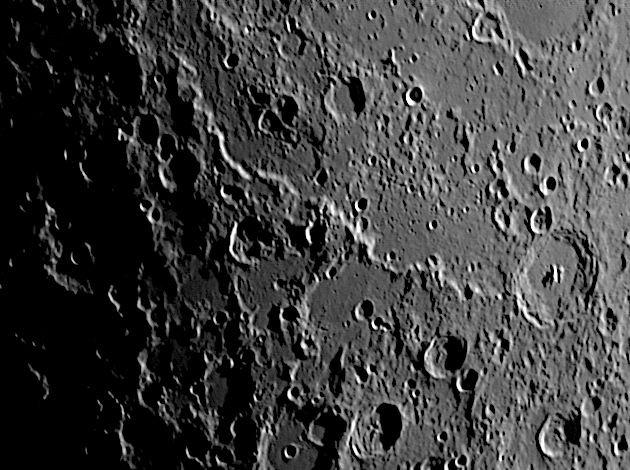
|
This is an area similar to the lower part of the image above and was taken earlier in the lunar day. The image is much clearer than the earlier one and the four peaks in the centre of Piccolomini are clearly visible. The Altai Scarp, which crosses the central part of this image, is the outer ring of the Nectaris basin, and it can be seen here that the area just within it is not nearly as smooth as my earlier picture implied.
The scale markers are approximately 100 Km north and east.
The picture was taken with a ToUcam attached to my LX200 on 6th June 2006 at 21:22 UT, when the Moon was 6.4 days old.
Lunar Phase: 57.8°
Colongitude: 35.8°
Date and Time: 6th June 2006 21:22 UT
Camera: ToUcam 740K
Telescope: LX200 at prime focus and IR-pass filter
Capture: K3CCDTools. High gamma, 1/100", 0% gain
Processing: Registax. 95 frames stacked, wavelet 1-2 = 10, gamma 1.7 |
|
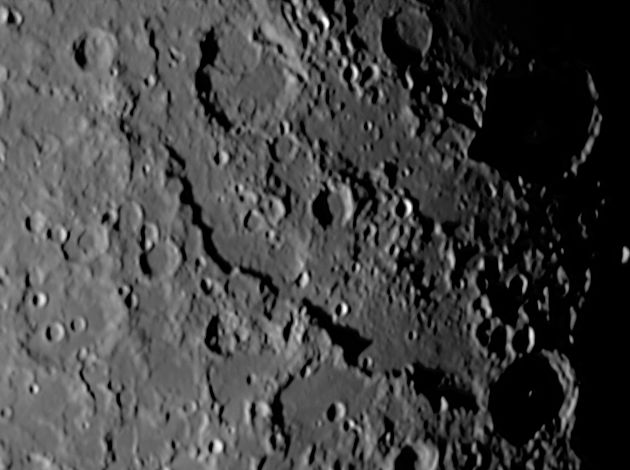
|
This is the same area as in the picture above, but imaged a day later than the mosaic second from the top of the page. The shadows really bring out the scarp and show that it falls from west to east.
The scale markers are approximately 100 Km north and east.
The picture was taken with a ToUcam attached to my LX200 on 10th December 2006 at 01:02 UT, when the Moon was 19.9 days old.
Lunar Phase: 298.5°
Colongitude: 146.4°
Date and Time: 10th December 2006 01:02 UT
Camera: ToUcam 740K
Telescope: LX200 at prime focus and IR-block and Skyglow pollution filters
Capture: K3CCDTools. High gamma, 1/10", 14% gain
Processing: Registax. 18 alignment points, 388 frames stacked, wavelet 1-2 = 10 |

